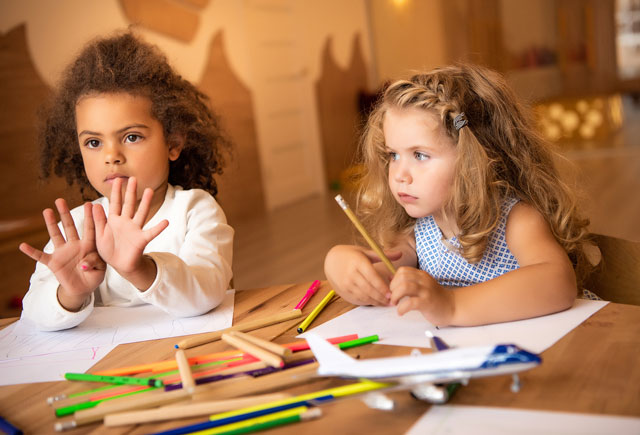Explore resources relevant and activities to courses that explore philosophical and practical foundations for teaching art in early childhood settings. These types of courses focus on the value of art in the curriculum, artistic development and instruction, and observation and guided teaching practice.
Course Activity 1: Developmental Stages (Drawing and Scribbling)
Remind students that scribbling and drawing follow developmental stages. Share the suggestions on the Tip Sheet, Power of the Pen: Drawing and Scribbling and ask students how they incorporate children’s drawings and scribbling in their classrooms. Using examples of children’s scribbling, have students work in pairs to order them by ages. (e.g., Zero to Three Learning to Write and Draw.)
Course Activity 2: Things to Do While You’re Waiting (Art)
The tip sheets Things to Do While You’re Waiting: Art Works! and Things to Do While You’re Waiting: Art is All Around include helpful ideas families might try when they are waiting with young children (e.g., medical appointments, bus stop, in line at the store, etc. Today families often pass their cell phone to their child and have them watch videos while waiting. Students can discuss how letting young children watch videos on a phone may be helpful at times but may also decrease meaningful opportunities for adult/child interactions.
Course Activity 3: Environmental Art
What ideas for noticing environmental art and art activities have students had experience with either with the young children they teach or with their own children? What art materials would they recommend taking along when they know there may be a long wait time for children? Have students write a lesson or activity plan for an outdoor visual arts experience for young children. They may use ideas from the tip sheets, Out and About with Preschoolers: Close Up with Visual Arts and Out and About with Preschoolers: Visual Arts to link visual arts to nature. Students should include details about outdoor setting (e.g., playground, backyard, the woods) and how they would intentionally address children’s benchmarks during the experience. Stress to the students that the process of creating art is always more important than the product.
Course Activity 4: Open-Ended Art Activities
Open ended art activities provide opportunities for young children to express themselves creatively. Open-ended art materials allow children to also meet benchmarks in several developmental areas. Watch the IEL Video Mila Paints the Fence. Students may want to turn on the closed captioning to hear the dialogue between Mila (age 3) and the adult visitor as they talk about her painting. Students can discuss how the visitor engages Mila in a discussion about the painting.
In the IEL video clip, Mila Sticks with Art Mila is now 5 yrs. old. What differences do students notice about Mila’s art activities as she becomes older?
Course Activity 5: Sharing Children’s Art with their Families
Open-ended art activities provide time for children to use new materials in different ways. Students can discuss with the class their ideas about sharing open-ended art projects with children’s families. What information is helpful for families to know about open-ended art activities in early childhood settings? Why might parents or grandparents expect to see displays of art projects that “look like what they made in school”?
Course Activity 6: Tips for Exploring Visual Arts
Students can write a brief explanation for families about what children learn from experiences with visual art in the classroom, in the community, and at home. They may add their written explanation and provide links to the Standards Start at Home Slides, Tips for Exploring the Visual Arts with Children (slides 1 and 2), in their portfolio or classroom website.
Course Activity 7: Art in Three Dimensions
Read the IEL Blog, Challenge Young Artists to Create in Three Dimensions. The instructor and students may bring items to class that they can use to create some three-dimensional art pieces. This can be done as individual art pieces or working in pairs. Students can process what it felt like to create a three-dimensional art piece. What was easy? What was challenging? Have students discuss how they incorporate this type of visual art activity in their future or current classroom.
Course Activity 8: Every Day Art Activities
After reading the IEL Blog by Dr. Rebecca Swartz, Make Art a Part of Every Day: Focus on Process students can create a list of the positive reasons for offering young children opportunities to experience art activities each day in the classroom. Why is it important for teachers to be intentional about creating an organized art center for children to use? What materials should you find in an art center? Why is the organization of the materials important for children’s learning? What do students know about how art is experienced by children attending preschool in a Reggio Emilia inspired setting? Encourage students to do research about how art is taught in different early childhood settings and report back to the class.
